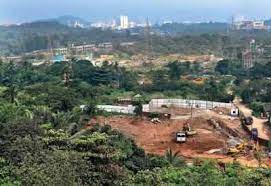This monsoon, as we moved closer to Gangotari from the holy town of Uttarkashi, the hum of demon-sized machines, bulldozing sounds of construction vehicles, and dynamite explosions became as perennial as the river Bhagirathi down below the serpentine and muddy road. The dusk was already drawing its dark shades amidst uninterrupted drizzling. The bewildered driver of our vehicle was silently and fearfully negotiating the sharp and unexpected bends even as the friends (two of them from southern India) with me seemed wondering if the nature was being exploited in the crudest manner. And the machines, construction vehicles and deafening dynamite explosions were self-explaining.
The animated silence ultimately broke into an ecological dialogue. I told my friends that the contracted construction companies never gave us a second thought when it came to blasting the mountainsides, deplete forests and consume resources in the name of development because their corporate needs were never satiated. No matter how the men and their machines try to define these project companies as agents of change — the change for the betterment of all, particularly the local hill people. I told them that similar companies or commercial contractors do not hesitate in carrying out more than permissible extraction of natural resources such as timber, resin, limestone, magnesium, and potassium by destructive means.
The ongoing process of road construction that necessitates blasting and quarrying of mountainsides in turn has led not only to massive erosions and landslides but the subsequent loss of soil, forest and water. As a consequence, serious economic and social dislocation of people in the hills has become rampant.
Echoes of Chipko slogans still reverberate in the hills three decades on. One could feel the same kind of sentiments at a three-day-long meeting organised by the Citizens’ Global Platform India in collaboration with the organisations like Human Rights Law Network, Aman Uttarakhand and Himalaya Paryavaran Shiksha Sansthan at Matli in Uttarkashi district of the state. People’s anger against the state government’s indifference towards their grassroots problems was quite pronounced.
Even today, while passing through the Chamba area in the district of Tehri Garhwal, one would hardly believe that a visitor to the court of the then king of Garhwal, in 1793, had proclaimed that the local forests were extensive and the trees were of great magnitude. Today, it is a bald story, no trees of magnitude and no extensive forests. Such a situation has been created because of excessive human intervention in the domain of nature. The situation has come to such a pass that most mountainous parts the state have already moved away from subsistence peasant economy to an economy dependent on outside remittances or the ‘money-order’ economy. The dependence on the money-order economy has contributed negatively in the sense that a large size of peasants has almost stopped paying attention to agriculture and the local environment. This is evident from a visit to any distant area in any districts of the state.
The human intervention has its deeper imprints on the people living near the deforested areas or near large hydro projects like Tehri dam. As a result, women spend longer hours in searching for firewood. The time spent collecting firewood and fodder invariably exceeds 16 hours a day and returns are miserable. The unavailability of green fodder has also resulted in the decline of fodder trees as well as in animal husbandry.
Deforestation began at a large scale as the conquerors plundered the best trees of the lower foothills. Even after large parts of Garhwal and Kumaon came under the direct British rule, there was no change for the forests. As a result, logging severely impacted the CHR. Railroad constructions also put an extra burden on the slow-growing chir (pine) and deodar (cedar) trees. The scars seem to be visible even today. A precious local variety of cedar called Kail is also fast disappearing. The extractive shift has also destroyed the once harmonious relationship the local people had with their environment. Vital change in species of trees and biodiversity is taking place in silence. The ‘congress’ grass or lantana is one such example. The multicultural species of trees still are being replaced by mono-cultural species of trees like eucalyptus. Now, the people find themselves helpless in repairing their environment.
Though the forest area is said to be about 67 percent of the hilly part of the state, the recent official figures estimate forest cover to be just 37.5 per cent and about half of this forest area is degraded with poor tree density. Recent satellite data show that of the 34,042 sq kms of land declared as forests in the region, good tree cover exists on only 6.6 per cent of this land, while another 22.5 per cent and 13.8 per cent are classified as medium and poor forests, respectively.
There is no answer to the woes of those peasants who invariably depend on the forests for fuel, fodder, and agricultural implements, timber for their houses, medicines and in times of scarcity of food. Deforestation has conspicuously dislocated the local communities. Environmental deterioration and the fall of the great forests continue to push the people to the plains while the severely burdened hill women still have to toil.
If you happen to indulge in a dialogue with a local person on any subject, the concluding part of the talk is always centred on the ecological concerns — the concern of State monopolising the gifts from nature.
The subsistence-oriented farming system, dependent upon the land and the forests, has its share in the cumulative social and environmental damages in the name of development.
The hydroelectric sites along Ganga-Yamuna and their tributaries are being exploited as roads made them accessible. Today, there are more than 200 hydroelectric projects in various stages in the mountainous state. One of them is the Tehri hydro development project, proudly touted as Asia’s largest earth-filled dam. The State’s insensitivity has only camouflaged the fact that the lake has not only submerged historic Tehri town and more than 100 villages and several hundred hectares of agricultural land, rendering more than 40,000 people homeless.
Tourism has also become more like a problem and the increased movements of people to the pilgrimage sites such as Kedarnath, Badarinath, Gangotari and Yamunotari have only aggravated the situation as hundreds of thousands of people motor to such places round the year. Trekking, hunting, fishing, and mountain climbing, etc., are yet another areas of concern.
The haphazard growth of hotels, shops and restaurants has added fuel to the fire. These people leave tones of plastic and other solid garbage unmindful of their duty to keep the local environment clean and unpolluted.
This growth has greatly impacted the region, seriously affecting the fragile mountain ecology. A proposal to construct a motorable road to the higher altitude religious shrine of Sikhs, Hemkunt Sahib, is a very serious threat to the ecology of the famous Valley of Flowers.
The threat of changing climatology in the CHR glaciers that feed several tributaries of Ganga and Yamuna are receding at a very fast rate. The impact of global warming is already upon the sensitive ecozone. According to a local in Gangotari, the Gangotari glacier, the second largest among the 6,500-odd small and large glaciers in Himalaya, has reduced to only 29-kms in length. Accordingly, the width and thickness have also been affected. The famous Gangotari glacier has receded 100 metres in last one year. In fact, the process of its recession had started as back as early 1780’s.
The question is: How long will it take Ganga to become a seasonal river? If a World Bank report is to be believed, the life-span of the river is less than 100 years — to be specific, some 70 years from now. Also, it is moving towards northeast with the most polluted stuff. The fast recession is worrying indeed. In fact, the rate of retreat in the last three decades has been more than three times the rate during the earlier two centuries. Stories of other prominent glaciers in the CHR such as Pindari are no different.
This, glaciologists and climatologists believe, is due to global warming. The climatic change brought about by human activity in the post-industrialisation period has already resulted in a global increase in the average surface temperature by 0.6 degree centigrade. A natural consequence of this is increased melt from ice caps and glaciers. Mountain glaciers, such as in the CHR, are particularly sensitive indicators of climate change.
Ecological Concerns
After getting full statehood in November 2000, Uttarakhand has become even easier target for the vested interests of private entrepreneurs in collusion with the political leadership of the state. The ecological concerns in the CHR do not, however, belong to the region alone. Studies have already indicated how movements and activities in this eco-zone have affected the life and support systems beyond and farther the mountain chain. Therefore, the issues related to its sustainable development and ecological regeneration process need to be viewed in a global perspective. The women are the ones most affected by environmental degradation.
It is regrettable that the potential of environmental policies in social and economic development of the new state continue to be underestimated and undermined despite an elected government in place. One reason is that economic growth and neo-liberal trade policy undermine environmental governance and policies, both international and national.
The ecological issues need to be seen beyond political boundaries and considerations, and considered essentially as human rights. The local people must not be denied their right to existence and livelihood based on their local knowledge systems. They must also not be uprooted and displaced without taking responsibility to adequately compensate and rehabilitate them.
The policies need to be equitable in terms of gender, socio-cultural, politico-economic, and ecological spheres; peaceful, mutual, consensus, balanced, transparent and accountable, placing the grassroots in the core. There is a need to recognise the people’s desires and aspirations, besides allowing them to achieve higher levels of self-reliance and gain control over their own lives and environment.
No respect for people’s movements has left deep scars in the hearts of the hill people. Earlier Tehri and now Falinda hydro project have shown State’s utter indifference towards the local people’s rights over their own waters, forests and lands. Latest, people in Chham had to protest under the leadership of a local leader, Jot Singh Bisht, to draw administration’s attention towards their genuine demands. How can any system of governance maintain silence when the surging waters of the Tehri dam are affecting a large number of people?
Therefore, the need of the hour is to take into account the local contexts, socio-physical relationships, priorities and constraints as well as the perspectives as wide as human rights, environmental justice and labour into account while setting an agenda for the real ecological democracy in Uttarakhand. This is the only way to create a condition where the local people can reap the fruits of the advancement in technology. The Rio Declaration on environment and development, adopted at United Nations conference on Earth and Development in 1992, remains to be fulfilled for these people.



